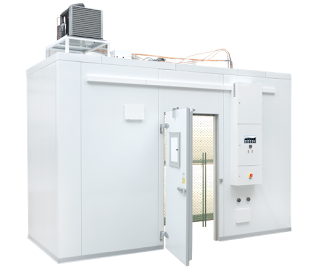 |
| Matching controlled environment air flow pattern, velocity, and volume to the application is part of delivering a well performing system photo courtesy Percival Scientific |
This article is about controlled environment rooms, but much of what is included here is also applicable to smaller sized chambers.The design of air flow in a controlled environment room can be impacted by a number of factors, some of which may be based on specific application requirements, and others that may be influenced by cost, production simplicity, or other factors unrelated to the performance goal of the equipment.
What aspects of controlled environment room air flow bear on performance?
- Velocity - In the common usage of the term when referring to air flow, the speed of the moving air. Depending upon the air moving equipment arrangement and any dispersion devices, such as perforated suspended ceilings or wall plenums, air velocity can vary throughout a chamber. Users should consider how their work may be impacted by air flow velocity. The storage of material in closed and sealed containers may be impervious to air velocity effects because the "product" within the container is not in contact with the moving air. Plants and insects, on the other hand, are an example of items that may be significantly or severely impacted by air velocity. Higher air velocity at a chamber location exposes that location to more air per unit of time. Desiccation is one possible concern that is exacerbated by increased air velocity. Higher velocity can also be beneficial, even necessary, for some applications. Rapid cooling or heating of materials placed within a chamber is enhanced by increased air movement across the material surface.
- Volume - The volumetric flow of air through a controlled space or chamber is needed to transfer heat to or from the space in order to maintain temperature control. Much of the air in a controlled environment room is recirculated, with cooling, heating, and in some cases moisture applied to condition the air in the room to the setpoint. The volume of air movement is loosely related to velocity, so increasing volume will result in an increase in velocity unless other design changes are made with respect to how the air is dispersed throughout the room. Higher volume, or turnover rate, contributes to better temperature uniformity in the room. As with velocity, there may be application specific requirements for low air movement. Keep in mind that low air movement creates challenges to the attainment of close temperature control and uniformity.
- Pattern - The way in which air is distributed throughout the controlled environment room can impact system performance once materials are placed in the room or process work is commenced. Empty chambers generally perform well, regardless of the air flow pattern, because there is little in the way of a load on the system and no solid materials in place to block or redirect air flow. Consideration should be given to the way in which air is dispersed throughout the work area. Loading patterns for stored product or the placement of work in process should be accommodated by the air flow pattern.
Matching the right air flow characteristics to the work to be achieved in a controlled environment room will result in better overall performance, not just when empty chamber tests are conducted, but when real work is being accomplished.
Share your environmental chamber and controlled environment room requirements and challenges with application experts. The combination of your own experience and knowledge with their specialized technical expertise will yield an effective solution.
No comments :
Post a Comment